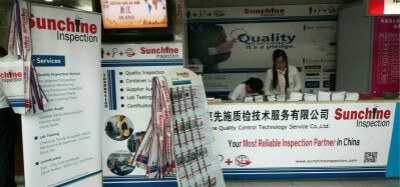Founded in 2005, Sunchine Inspection is one branch of Sunchine International; a Hong Kong based multinational company specializing in export-import consulting and quality management. Today, with two offices in China mainland and one office in Europe, Sunchine Inspection has become one of the best third party inspection companies in China, serving over 1,500 regular clients in various fields from all the Continents in the world.


BY RENAUD ANJORAN
In 2005, when an importer asked their best manufacturer for a report that shows their own inspection findings, they seldom received a document. They were usually told “no problems were found”. Getting a few digital photos by email was already an accomplishment.
Things have changed. In most industries, the best manufacturers are used to producing QC inspection reports for their internal use. There are several reasons for this:

It is a management tool — quality keeps production honest, and shipping a substandard batch requires multiple sign-offs.
The factory top managers have understood that savings a few bucks today and getting heavy chargebacks (or even losing a significant customer) in 2 months is not good business.
They sometimes decide to share their own reports with customers, as an attempt to avoid being inspected (since welcoming an inspector, unpacking, repacking, etc. takes a lot of time). And sometimes it works.
As a rational purchaser, I would certainly want to look at the opportunity to reduce, and maybe even eliminate, the QC inspections performed in the best factories that ship products for me.

It is a management tool — quality keeps production honest, and shipping a substandard batch requires multiple sign-offs.
The factory top managers have understood that savings a few bucks today and getting heavy chargebacks (or even losing a significant customer) in 2 months is not good business.
They sometimes decide to share their own reports with customers, as an attempt to avoid being inspected (since welcoming an inspector, unpacking, repacking, etc. takes a lot of time). And sometimes it works.
As a rational purchaser, I would certainly want to look at the opportunity to reduce, and maybe even eliminate, the QC inspections performed in the best factories that ship products for me.
From my discussions with a number of quality and procurement managers in China, more and more of them are coming to look at their supplier base this way:
Supplier self inspection best case
Category 1: low volume of business
These suppliers only ship products irregularly. The amount is low. Purchasers don’t even know if the same manufacturing facility is used over time. It doesn’t make much sense to get to know them better. No change for these ones!
Category 2: low quality risk based on historical data
These suppliers have demonstrated that (1) they are not likely to play games, and (2) their product quality is consistently good. As a reward, they can be extended a higher level of trust. These are the best candidates for supplier self-inspection.
(Let’s face it, random inspections don’t catch all issues. I wrote before about the 5 main limits of AQL inspections. It is an imperfect tool.)
This can be done in combination with a skip-lot inspection program (the buyer can decide to check 20% of the batches before shipment randomly and with minimal prior notice, for example).
Unfortunately, this category of suppliers might represent 10-30% of the total purchased amount. What about the other suppliers who also represent a substantial flow of business and that are not really good?
Category 3: suppliers that need to improve
You still need to pay for the inspections of their products, and pay for their quality issues (whether you detect them or not, they create delays, arguments, etc.).
But hopefully you want them to get better over time. If they show positive signs (the boss is motivated to make changes etc.), it might make sense to help them.
What you can do as the buyer
Try to set up an overall supplier development program. You could look at the categories 2 and 3 this way:
Supplier improvement program virtual circle
How can you push some suppliers for improvement? Here are a few basics…
www.tagged.com/electricinspection
www.tagged.com/chemicals6inspection
www.tagged.com/commodities44inspection
www.tagged.com/certificate5quality
www.tagged.com/chinaagent22
www.tagged.com/audit5service
www.tagged.com/verification444services
www.tagged.com/glass3inspection
www.tagged.com/garment3quality
www.tagged.com/chemicals6inspection
www.tagged.com/commodities44inspection
www.tagged.com/certificate5quality
www.tagged.com/chinaagent22
www.tagged.com/audit5service
www.tagged.com/verification444services
www.tagged.com/glass3inspection
www.tagged.com/garment3quality
You need regular monitoring and data collection:
Audits of the factory’s quality system and processes
Most common defects per process/product type
Based on these data, corrective action plans can be set in motion and their effectiveness can be followed up. If they do this seriously, and if they get help where necessary, they can probably be awarded the privilege of self-inspections.
Most common defects per process/product type
Based on these data, corrective action plans can be set in motion and their effectiveness can be followed up. If they do this seriously, and if they get help where necessary, they can probably be awarded the privilege of self-inspections.
Now, letting a supplier check their own product quality should only take place under certain conditions. And there will always be limits to that approach. I’ll write a follow-up article on that… https://www.sunchineinspection.com/
没有评论:
发表评论